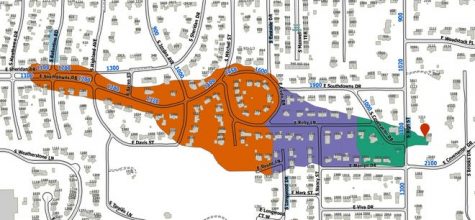On Friday, November 5, lead paint chips fell from the sky onto the lawns and houses of Hoosier homeowners. Now, those in the contamination site still have questions about when their homes will be safe again.
After the Bloomington Fire Department conducted a controlled burn at a house scheduled for demolition on South High Street, ash and paint chips drifted through the neighborhoods west of the property. Concerned homeowners suspected the presence of lead, and at-home tests revealed positive results. Paint samples from the contamination site, which currently extends from South High Street west all the way to Ballantine Road and Southdowns, were tested by Gabriel Fillipelli’s lab at IUPUI. Leah Wood, a graduate student at Fillipelli’s lab who conducts environmental lead research, confirmed the presence of lead during a City Council Zoom meeting on November 10. “The vast majority [of the samples] were so high that it makes more sense to measure them in percent lead, sadly, instead of parts per million,” said Wood. The highest concentration of lead found in the 38 samples was 10.8%, and the average amount was 4%. “These are extremely high values,” said Wood.

The house at the burn site was donated to the BFD as an opportunity for firefighters to practice in a real-world environment. According to a press release from the BFD on November 1, “structure firefighting is a complex, high-risk, low-frequency event, with multiple variables interacting simultaneously.” Because of this, controlled burns are a rare opportunity to give new firefighters valuable experience with fighting house fires.
The BFD obtained a demolition permit and had the burn reviewed by the Indiana Department of Environmental Management (IDEM) before November 5. Per IDEM requirements, firefighters disconnected all utilities and removed all potentially toxic items from the house before beginning the burn, including “furniture, carpeting, asphalt roofing shingles, roofing underlayment, and vinyl siding,” according to the November 1 press release.
Currently, it’s unclear why the BFD didn’t check for lead paint during their review of the site. “Lead paint was not one of the testing criteria so it was not tested for lead prior to the approved live fire training evolution,” said Fire Chief Jason Moore in an interview with the Herald-Times. The Environmental Protection Agency website’s list of requirements for open burns does not mention lead.
In the November 10 City Council Zoom meeting, Indra Frank of the Hoosier Evironmental Council explained the dangers of lead poisoning. “Lead is a toxic heavy metal… it gets into the body through accidental ingestion of dust or from inhalation,” said Frank. “It’s especially toxic for children or for the developing fetus. Children who are lead poisoned end up with permanent damage that reduces their I.Q. and puts them at higher risk for behavior problems.” Even extremely low levels of lead exposure can be damaging to young children — Frank explained that 3.5 micrograms of lead per deciliter of blood are considered poisoning. “A microgram is a tiny, tiny amount,” said Frank. Lead paint was banned in 1978, but the house at the address was built in 1961. “My understanding is that this house was old enough to have lead paint on it,” said Frank.
South Senior Tilly Robinson lives less than 500 feet from the burn site and had paint chips on her property. “Obviously, I was alarmed because of the effects of lead poisoning, but I wasn’t necessarily feeling anger. It’s really frustrating that there was this oversight on the part of the fire department, but according to the information, they did their best,” said Robinson. “It’s more of a fluke than an injustice, in my opinion.” Robinson commented on the difference between this situation and other environmental contamination cases like in Flint, Michigan, where lead leached into the water system of an entire city. “In this case, major race and class disparities didn’t contribute to the situation,” said Robinson.
Stephanie Warner, a social studies teacher at South, is another Panther in the contamination site. She has young children in her home and is worried about the exposure that her kids may have had before the city released warnings about the contamination. “My pets have been outside like crazy, and same with my kids. I guess it’s just hard to know what to do,” said Warner.
Currently, the city has contracted an environmental mitigation crew to clean up exposed areas. For homeowners, the best way to mitigate potential lead exposure is to vacuum up any paint chips with a HEPA-approved vacuum bag and wipe down surfaces inside the home. It’s recommended to take off shoes before coming inside the home and limit time outside, especially for young children or pets.


